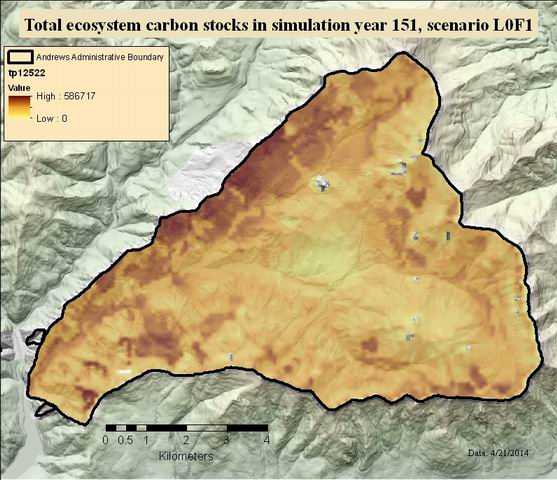Total ecosystem carbon stocks in simulation year 151, scenario L0F1
Raster Dataset

Tags
Blue River Watershed,
Willamette Basin, Oregon, HJ Andrews Experimental Forest
The purpose of this study was to determine the role and contribution of biological legacies to the resilience of the HJ Andrews landscape after large, high severity fire. Resilience is quantified for three indicators, i.e., total ecosystem carbon storage, canopy complexity (rumple index), and presence of late-seral species on the landscape.
Total ecosystem carbon stocks in simulation year 151, scenario L0F1: Simulation results for the scenario with no initial biological legacy and historic fire return interval
Disturbances are key drivers of forest ecosystem dynamics, and forests are well adapted to their natural disturbance regimes. However, as a result of climate change, disturbance frequency is expected to increase in the future in many regions. It is not yet clear how such changes might affect forest ecosystems, and which mechanisms contribute to (current and future) disturbance resilience. We here studied the 6364-ha HJ Andrews Experimental Forest landscape to investigate how patches of remnant old-growth trees (as one important class of biological legacies) affect the resilience of forest ecosystems to disturbance. Using the spatially explicit, individual-based forest landscape model iLand we analyzed the effect of three different levels of remnant patches (0%, 12%, and 24% of the landscape) on 500-year recovery trajectories after a large, high severity wildfire. In addition, we evaluated how three different levels of fire frequency (no fire, a historic fire return interval of 262 years, and a reduced fire return interval of 131 years) modulate the effects of initial legacies. The study investigated effects of legacies on the resilience of forest ecosystem structure (represented by canopy complexity as described by the rumple index), composition (proportion of late-seral species), and functioning (total ecosystem carbon storage). For each scenario of initial legacy and fire return interval 25 replicates were simulated. More information on the simulation methodology as well as the code and executable used for this study can be obtained at http://iLand.boku.ac.at. The dataset is completed and no further analyses are planned at this point. The results are published in Ecological Applications http://dx.doi.org/10.1890/14-0255.1.
There are no credits for this item.
While substantial efforts are made to ensure the accuracy of data and documentation, complete accuracy of data sets cannot be guaranteed. All data are made available "as is". The Andrews LTER shall not be liable for damages resulting from any use or misinterpretation of data sets.
Extent
West -122.261948 East -122.100517 North 44.281483 South 44.197514
Maximum (zoomed in) 1:5,000 Minimum (zoomed out) 1:150,000,000